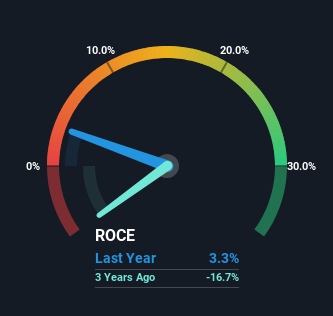- India
- /
- Energy Services
- /
- NSEI:GLOBALVECT
Capital Allocation Trends At Global Vectra Helicorp (NSE:GLOBALVECT) Aren't Ideal
Did you know there are some financial metrics that can provide clues of a potential multi-bagger? One common approach is to try and find a company with returns on capital employed (ROCE) that are increasing, in conjunction with a growing amount of capital employed. Basically this means that a company has profitable initiatives that it can continue to reinvest in, which is a trait of a compounding machine. However, after briefly looking over the numbers, we don't think Global Vectra Helicorp (NSE:GLOBALVECT) has the makings of a multi-bagger going forward, but let's have a look at why that may be.
What Is Return On Capital Employed (ROCE)?
Just to clarify if you're unsure, ROCE is a metric for evaluating how much pre-tax income (in percentage terms) a company earns on the capital invested in its business. To calculate this metric for Global Vectra Helicorp, this is the formula:
Return on Capital Employed = Earnings Before Interest and Tax (EBIT) ÷ (Total Assets - Current Liabilities)
0.033 = ₹140m ÷ (₹9.3b - ₹5.0b) (Based on the trailing twelve months to March 2024).
Therefore, Global Vectra Helicorp has an ROCE of 3.3%. Ultimately, that's a low return and it under-performs the Energy Services industry average of 6.9%.
View our latest analysis for Global Vectra Helicorp

Historical performance is a great place to start when researching a stock so above you can see the gauge for Global Vectra Helicorp's ROCE against it's prior returns. If you'd like to look at how Global Vectra Helicorp has performed in the past in other metrics, you can view this free graph of Global Vectra Helicorp's past earnings, revenue and cash flow.
What Does the ROCE Trend For Global Vectra Helicorp Tell Us?
In terms of Global Vectra Helicorp's historical ROCE movements, the trend isn't fantastic. To be more specific, ROCE has fallen from 8.8% over the last five years. Although, given both revenue and the amount of assets employed in the business have increased, it could suggest the company is investing in growth, and the extra capital has led to a short-term reduction in ROCE. And if the increased capital generates additional returns, the business, and thus shareholders, will benefit in the long run.
Another thing to note, Global Vectra Helicorp has a high ratio of current liabilities to total assets of 54%. This effectively means that suppliers (or short-term creditors) are funding a large portion of the business, so just be aware that this can introduce some elements of risk. Ideally we'd like to see this reduce as that would mean fewer obligations bearing risks.
The Key Takeaway
Even though returns on capital have fallen in the short term, we find it promising that revenue and capital employed have both increased for Global Vectra Helicorp. And the stock has done incredibly well with a 618% return over the last five years, so long term investors are no doubt ecstatic with that result. So should these growth trends continue, we'd be optimistic on the stock going forward.
Global Vectra Helicorp does come with some risks though, we found 3 warning signs in our investment analysis, and 2 of those shouldn't be ignored...
For those who like to invest in solid companies, check out this free list of companies with solid balance sheets and high returns on equity.
New: Manage All Your Stock Portfolios in One Place
We've created the ultimate portfolio companion for stock investors, and it's free.
• Connect an unlimited number of Portfolios and see your total in one currency
• Be alerted to new Warning Signs or Risks via email or mobile
• Track the Fair Value of your stocks
Have feedback on this article? Concerned about the content? Get in touch with us directly. Alternatively, email editorial-team (at) simplywallst.com.
This article by Simply Wall St is general in nature. We provide commentary based on historical data and analyst forecasts only using an unbiased methodology and our articles are not intended to be financial advice. It does not constitute a recommendation to buy or sell any stock, and does not take account of your objectives, or your financial situation. We aim to bring you long-term focused analysis driven by fundamental data. Note that our analysis may not factor in the latest price-sensitive company announcements or qualitative material. Simply Wall St has no position in any stocks mentioned.
Have feedback on this article? Concerned about the content? Get in touch with us directly. Alternatively, email editorial-team@simplywallst.com
About NSEI:GLOBALVECT
Global Vectra Helicorp
Provides helicopter services for the oil and gas sector in India.
Good value with imperfect balance sheet.
Market Insights
Community Narratives



